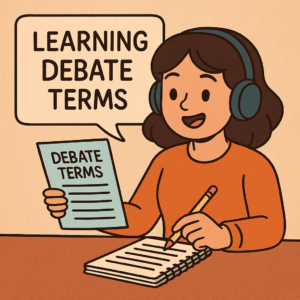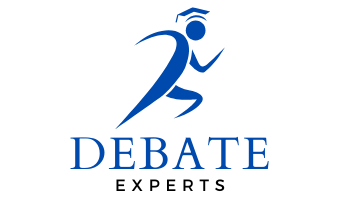Essential Debate Terms for Competitive Debate
Whether you’re stepping into your first tournament or just trying to follow what the heck a “flow” is, competitive debate can feel like its own secret language. And truth is, it kinda is. From “constructive speeches” to “drops” and “weighing mechanisms,” every round is packed with shorthand, strategy, and structure.
If you want to level up, understanding the lingo is a must. This guide breaks down the most important debate terms you’ll hear across all formats like Lincoln-Douglas, Public Forum, Policy, and Parliamentary. We built it with simple explanations, real-world comparisons, and a touch of friendly advice to keep you in the game (and maybe ahead of it).
Why Debate Terminology Matters
If you’ve ever sat in a debate round and heard someone say “they dropped our solvency argument, so extend it and weigh it on magnitude,” and felt like they were speaking in Morse code, you’re not alone.
Debate is a game of ideas, but also of language. The faster you become fluent in its vocabulary, the quicker you’ll feel confident, organized, and persuasive. Like most niche subjects or industry, debate is filled with unique terms that you have to learn by heart and internalize. This will allow you to compete at the highest level and reach your academic, competitive and professional goals like Barack Obama did. (Yes, he loved debate)
Here’s why it counts:
- Clarity wins rounds. Judges are often flowing 3–4 arguments at once. Knowing the right words helps you signal what matters and when.
- Confidence builds ethos. Using the right terms shows you’re prepped, aware, and serious. It subtly boosts your credibility (even if you’re still learning).
- Terminology is tactical. Some terms carry weight. “Turn,” “drop,” “impact,” “pre-fiat”—these aren’t just jargon. They shape how the round is judged.
- Communication with teammates and judges. Whether it’s partner strategy in PF or judge adaptation in LD, shared language = smoother rounds.
You don’t need to memorize every word in the debate universe, but you do need to know the essentials—and we’ve got your back on that. It sounds like a lot, but many of us here tried to learn mandarin as English native speakers (so we promised that you can do it!).
Let’s break down the must-know debate terms that show up in every style—whether you’re rocking Lincoln-Douglas, battling in Public Forum, going deep in Policy, or bringing flair in Parli. These terms are universal, and knowing them will boost your clarity, flow, and overall strategy.
Each one comes with a simple definition and a real-world example (because let’s keep it human).
Core Terms Every Debater Must Know
1. Contention
A main argument or claim in your case. Think of it as a pillar holding up your position. Most speeches have 2–3.
🧠 Example: “Our first contention is that free college increases economic mobility.”
2. Rebuttal
👉 A response speech that attacks the other team’s arguments. This is where the clash begins.
Example: “Their contention about job loss ignores how automation was already affecting the industry.”
3. Crossfire / CX (Cross-Examination)
A Q&A session where debaters ask each other questions to clarify or poke holes in the argument. Can be spicy, can be chill.
🧠 Example: “Would you agree that correlation doesn’t equal causation in your study?”
4. Drop
👉 When a team fails to respond to an argument. Big deal. In debate, silence = concession.
Example: “Extend our impact—opponents dropped it completely.”
5. Extend
To bring an argument forward in the next speech. You’re reminding the judge it still stands (and why it matters).
🧠 Example: “Extend our contention about economic growth—it went unchallenged.”
6. Impact
👉 The why it matters part. You can win logic, but if it doesn’t have impact, it won’t win the round.
Example: “This policy prevents 10,000 deaths annually—that’s our impact.”
7. Turn
👉 Flipping the argument back at your opponent. You show that their logic actually helps your side.
Example: “They say tech causes job loss, but we turn it: tech creates higher-paying jobs in new sectors.”
8. Flow / Flowing
Debate note-taking system used to track arguments. Each speech gets its own column.
🧠 Pro tip: Learn to flow early. It’s your secret weapon.
9. Framework
👉 The lens through which a debate should be judged. Think: fairness, utilitarianism, rights, etc.
Example: “Under a utilitarian framework, we must choose the policy that maximizes well-being.”
10. Weighing
Comparing impacts or arguments to show which one matters more. This is often how rounds are won.
🧠 Example: “Even if they reduce unemployment, our argument saves lives—weigh on magnitude.”
11. Evidence / Cards
👉 Facts, stats, and expert quotes you read aloud or reference during the round. In Policy and PF, they’re often referred to as “cards.”
Example: “According to the Brookings Institution, 67% of…”
12. Pre-flow
Writing down your own case’s arguments in advance before the round begins.
🧠 Pro tip: Helps you stay organized when the nerves kick in.
13. Tagline
👉 A one-sentence summary of your argument. Like a headline.
Example: “Universal healthcare saves lives and boosts the economy.”
14. Voter
A reason the judge should vote for you. Usually brought up in final speeches.
🧠 Example: “Even if you buy their logic, our framework still outweighs. That’s a clear voter.”
15. Roadmap
👉 A quick preview of what you’ll cover in your speech. It keeps the judge oriented.
Example: “First I’ll respond to their case, then rebuild our arguments.”
We’ve built a PDF form with all the important terms and their definitions just for you. Download it here for free!
Format-Specific Terms: What’s Unique in LD, PF, CX, and Parli
Every debate format has its own flavor—and its own set of buzzwords. Whether you’re going solo in Lincoln-Douglas or tag-teaming in Policy, the style you choose influences how you speak, argue, and think.
Here’s a breakdown of the unique terms and quirks from the big four formats so you don’t show up to your first round asking, “Wait… what’s a K?”
🧍♂️ Lincoln-Douglas (LD) – One-on-one, values-driven
- Value: The core principle you’re arguing for (e.g. justice, liberty, equality).
“Our value is individual rights.” - Criterion: The measuring stick used to achieve the value.
“Through utilitarianism, we best achieve justice.” - Pre-fiat / Post-fiat: Arguments made about the theory of the resolution vs. real-world effects if enacted.
“Pre-fiat: it’s immoral. Post-fiat: it won’t work.” - Theory Shell: A structured argument claiming that the opponent’s behavior violates debate rules or norms.
Often starts with “Interpretation – Violation – Standards – Voter.”
🧑🤝🧑 Public Forum (PF) – Team of two, current events focus
- Pro / Con: Instead of “Affirmative” or “Negative,” you’re for or against the resolution.
“We’re on the Pro side today.” - Summary Speech: A short, powerful mid-round speech to crystallize key arguments.
“Extend our economic argument, they dropped it.” - Final Focus: Your team’s last shot—where you tie everything together and weigh impacts for the win.
“Vote for us because we save lives and they can’t prove solvency.” - Frontline: Pre-prepped responses to expected arguments in the round.
“We prepped a frontline for their China card.”
📑 Policy Debate (CX) – Heavy research, rapid delivery, deep strategy
- Plan Text: The specific proposal the affirmative is advocating.
“The US federal government should substantially increase renewable energy subsidies.” - Solvency: Proof that your plan will actually fix the problem.
“Our plan has empirical success in Denmark.” - Disadvantage (DA): A negative argument showing that the plan causes more harm than good.
“A new tax would tank the economy.” - Kritik (K): A philosophical critique challenging the assumptions or mindset behind the argument.
“Their plan reinforces colonialism.” - Topicality (T): An argument claiming the aff isn’t actually debating the resolution.
“They don’t meet the wording of the topic.”
🎩 Parliamentary Debate (Parli) – Improvised, fast-paced, witty
- Gov / Opp: Short for Government (affirmative) and Opposition (negative).
“Today, as the Gov, we’ll propose…” - Prime Minister Constructive (PMC): The first speech in the round. Sets the tone and introduces the case.
Delivered by the “Prime Minister.” - Points of Information (POIs): Interjections during an opponent’s speech—quick questions or rebuttals.
“On that point!” - Motion: The resolution or topic of the round, often presented just minutes before the debate.
“This House would ban targeted advertising.” - Opp Block: A back-to-back pair of speeches by the opposition—two chances in a row to hit hard before the final speech.

Advanced Terms You’ll Hear at Nationals (or Flex On with Your Friends)
If you’re cruising through local tournaments and want to break into more competitive circuits, these are the terms you’ll start hearing a lot more often. Some come from debate theory, others from philosophy, and a few just from deep strategy.
They’re not just fancy words—they’re tactical tools that can win rounds if used right.
1. Kritik (K)
A philosophical or ideological challenge to your opponent’s argument or assumptions. Popular in Policy and LD.
Example: “Their advocacy assumes the legitimacy of state violence—this K deconstructs that logic through Foucault.”
2. Link / Internal Link / Link Turn
A link is how your opponent’s plan connects to your disadvantage or Kritik.
An internal link shows how that connection leads to the impact.
A link turn argues the opposite—that the plan actually prevents the harm.
Example: “They link to our economy DA, but we link turn: their policy boosts investment, not hurts it.”
3. Uniqueness
Shows whether the impact is already happening or not. Useful in disadvantages.
Example: “Recession is already occurring—so their plan doesn’t uniquely cause it.”
4. Perm (Permutation)
In response to a Kritik or counterplan, this means trying to do both the aff and the alt/counterplan together.
Example: “Perm: do both—we can reform the system and adopt their critical lens.”
5. Fiat
The assumption that the affirmative’s plan will be implemented as proposed. We debate its effects, not the logistics.
Example: “Fiat allows us to skip political barriers and focus on outcomes.”
6. Pre-Fiat / Post-Fiat Impact
Pre-fiat: Philosophical or procedural impacts (e.g., oppression, framework fairness).
Post-fiat: Real-world consequences (e.g., war, climate change, economy).
Example: “The K’s pre-fiat impacts outweigh post-fiat harms—they attack the root mindset.”
7. Shell
A structured theory argument, often used to challenge abusive behavior.
Includes: Interpretation → Violation → Standards → Voter.
Example: “Their spikes are unanswerable—this shell shows why that’s unfair.”
8. Spikes / Triggers / Hidden Offense
Sneaky prewritten lines designed to make certain arguments hard to respond to or create automatic offense.
Example: “Their constructive had a spike against counterplans—we need to call that out in theory.”
9. Condo / Conditionality
In Policy, it refers to whether the negative team can kick out of a counterplan or Kritik whenever they want.
Example: “We’re running a condo shell—conditionality makes it impossible to prep fairly.”
10. Impact Calculus
The meta-level comparison of impacts—deciding which impact matters more and why.
Example: “Even if they prevent economic collapse, our impact saves the planet—we outweigh on scope and timeframe.”
How to Practice Using These Terms in Real Debates
Memorizing debate terms is great—but using them naturally under pressure? That’s where the real growth happens.
Here’s how to lock them in without sounding like a walking glossary:
1. Practice with Purpose
Every time you write a case or rebuttal, highlight the terms you’re using—like “weigh,” “extend,” “impact,” or “turn.” Make it a habit to say them out loud during practice speeches.
Repetition is how you go from “trying to remember” to “can’t stop saying it.”
2. Mock Rounds with a Twist
Try this exercise: Pick 5–10 key terms and challenge yourself (or your team) to use each one at least once per speech. It’s fun and keeps your brain alert.
Pro tip: record yourself and listen back—it’ll show where your phrasing shines or stumbles.
3. Create Flashcards — But With Examples
Don’t just memorize definitions. Create a flashcard for each term with an example from your own cases or rounds. This ties theory to reality.
4. Break Down Champion Rounds
Watch or read transcripts from winning rounds. Pause and identify the terms in action.
Ask yourself: How did that debater use “weighing” better than the other? Why did the judge buy the “framework”?
5. Teach Someone Else
One of the fastest ways to master something? Explain it simply to someone else. Run a mini-workshop for your team or a new debater. It’ll reinforce your understanding and earn you serious coach points.
Yes, Debate Terms Matter!
Learning the language of debate puts power in your hands. It helps you connect with judges, control the round, and build arguments that stick. If you need help understanding the different debate rules and formats, check out our article on getting started in debate!
So whether you’re just starting out or prepping for nationals, remember:
The more fluently you speak the language of debate, the more persuasive you become.
Now go extend those voters, flow those turns, and show the world you know your stuff.




